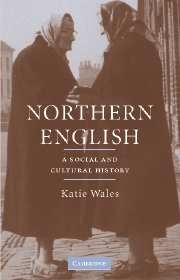Book contents
- Frontmatter
- Contents
- List of illustrations
- Preface
- List of abbreviations and symbols
- 1 ‘The North–South divide’
- 2 The origins of Northern English
- 3 Northern English and the rise of ‘Standard English’
- 4 Northern English after the Industrial Revolution (1750–1950)
- 5 Northern English present and future
- References
- Index of Northern English features
- General index
4 - Northern English after the Industrial Revolution (1750–1950)
Published online by Cambridge University Press: 22 September 2009
- Frontmatter
- Contents
- List of illustrations
- Preface
- List of abbreviations and symbols
- 1 ‘The North–South divide’
- 2 The origins of Northern English
- 3 Northern English and the rise of ‘Standard English’
- 4 Northern English after the Industrial Revolution (1750–1950)
- 5 Northern English present and future
- References
- Index of Northern English features
- General index
Summary
‘The two nations’: the impact of industrialization
On his English Journey in the 1930s J. B. Priestley finds himself approaching ‘home’ in the North Country. Near Huddersfield at sunset he describes how the hills ‘were beginning to take on … that Wordsworthian quality which belongs to the North … a brooding tenderness’ (1934: 155). He later notes how, because of the dales nearby, he and other Bradford folk ‘have Wordsworth in our very legs’ (p. 174). Because of the massive impact made on the North in particular by the Industrial Revolution it is all too easy for the Romantic image of the North presented in the last section of chapter 2 to have been replaced in modern cultural memory, especially in that of outsiders, by the ‘Lowryesque’ (Dodd 1990) of grime and grimness, mechanisation and misery. (See also chapter 1.) In another sense, however, the age-old image of the alien wastelands and ‘barbarity’ of the North is simply reconfigured: the medieval view of the North being the Devil's homeland replaced or reinforced by an industrial underworld. As Dellheim suggests (1986: 226), to sensitive Victorians the ugliness of the industrial North was mirrored in the uncouthness of the language. Yet for Northerners themselves, Priestley's Wordsworthian trope rings true. It is hard to invoke any modern Northern townscape that is not also inextricably linked with either sea-side, dale or moorland; and even the Northumberland and Durham pit-villages, well into the twentieth century, measured their daily lives according to the rhythms of country customs and rituals as well as those of the working shifts.
- Type
- Chapter
- Information
- Northern EnglishA Social and Cultural History, pp. 115 - 159Publisher: Cambridge University PressPrint publication year: 2006

